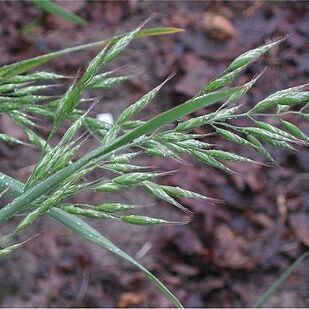Annuals or perennials, rhizomatous or stoloniferous or caespitose or decumbent, bisexual. Leaves auriculate or non-auriculate; sheath margins joined; ligule an unfringed membrane; blade rolled in bud. Inflorescences paniculate or rarely a single raceme (not in Australia). Spikelets usually pedicellate or rarely subsessile, laterally compressed, disarticulating above glumes and between florets, with (1–) 3–30 bisexual florets; rachilla extension with male or sterile florets. Glumes usually very unequal or rarely ±equal, awnless, keeled or not; lower glume 1–5 (–7)-nerved; upper glume 3–7 (–9)-nerved. Bisexual lemmas 2-lobed (in Australia) or entire, almost always 1 (–3)-awned or mucronate or awnless (not in Australia), keeled or not, (3–) 5–15-nerved; awn dorsal or subapical or from sinus, usually entered by several nerves. Lodicules not toothed. Stamens 1–3. Ovary with a conspicuous apical appendage, hairy; styles lateral to appendage. Caryopsis adhering to lemma and/or palea, laterally compressed; hilum long-linear.
Spikelets several-flowered, the rachilla disarticulating above the glumes and be-tween the florets; glumes acute, the first 1-or obscurely 3-nerved, the second 3-to 5-nerved; lemmas keeled, 5-to 9-nerved, awned from between the teeth of the minutely bifid apex; palea shorter than the lemma, thin, ciliate on the keels, ad-herent to the caryopsis. Slender perennials with closed sheaths, flat narrow blades, and open panicles of relatively large spikelets.
Spikelets with several to many fls, eventually disarticulating between the lemmas and above the glumes, oval to narrowly oblong, subterete or laterally flattened; glumes somewhat unequal, shorter than the lemmas; lemmas 3–9-veined, 2-toothed at the tip, awnless or more often awned between the teeth; spikelets large, often in lax or drooping panicles; sheaths usually closed nearly to the top. 100, widespread in temp. reg.
Annuals or perennials. Leaf-blades rarely auriculate; sheaths usually hairy. Panicle usually fairly large and open. Spikelets usually large, the lemmas well exserted from the glumes and awned from the sinus of the 2-toothed tip or from just below it, rarely with just an awn-point or mucro. Styles arising laterally from below the hairy apex of the ovary.


